Ju Jing
Prediction of Halo Coronal Mass Ejections Using SDO/HMI Vector Magnetic Data Products and a Transformer Model
Mar 05, 2025Abstract:We present a transformer model, named DeepHalo, to predict the occurrence of halo coronal mass ejections (CMEs). Our model takes as input an active region (AR) and a profile, where the profile contains a time series of data samples in the AR that are collected 24 hours before the beginning of a day, and predicts whether the AR would produce a halo CME during that day. Each data sample contains physical parameters, or features, derived from photospheric vector magnetic field data taken by the Helioseismic and Magnetic Imager (HMI) on board the Solar Dynamics Observatory (SDO). We survey and match CME events in the Space Weather Database Of Notification, Knowledge, Information (DONKI) and Large Angle and Spectrometric Coronagraph (LASCO) CME Catalog, and compile a list of CMEs including halo CMEs and non-halo CMEs associated with ARs in the period between November 2010 and August 2023. We use the information gathered above to build the labels (positive versus negative) of the data samples and profiles at hand, where the labels are needed for machine learning. Experimental results show that DeepHalo with a true skill statistics (TSS) score of 0.907 outperforms a closely related long short-term memory network with a TSS score of 0.821. To our knowledge, this is the first time that the transformer model has been used for halo CME prediction.
Prediction of Geoeffective CMEs Using SOHO Images and Deep Learning
Jan 02, 2025Abstract:The application of machine learning to the study of coronal mass ejections (CMEs) and their impacts on Earth has seen significant growth recently. Understanding and forecasting CME geoeffectiveness is crucial for protecting infrastructure in space and ensuring the resilience of technological systems on Earth. Here we present GeoCME, a deep-learning framework designed to predict, deterministically or probabilistically, whether a CME event that arrives at Earth will cause a geomagnetic storm. A geomagnetic storm is defined as a disturbance of the Earth's magnetosphere during which the minimum Dst index value is less than -50 nT. GeoCME is trained on observations from the instruments including LASCO C2, EIT and MDI on board the Solar and Heliospheric Observatory (SOHO), focusing on a dataset that includes 136 halo/partial halo CMEs in Solar Cycle 23. Using ensemble and transfer learning techniques, GeoCME is capable of extracting features hidden in the SOHO observations and making predictions based on the learned features. Our experimental results demonstrate the good performance of GeoCME, achieving a Matthew's correlation coefficient of 0.807 and a true skill statistics score of 0.714 when the tool is used as a deterministic prediction model. When the tool is used as a probabilistic forecasting model, it achieves a Brier score of 0.094 and a Brier skill score of 0.493. These results are promising, showing that the proposed GeoCME can help enhance our understanding of CME-triggered solar-terrestrial interactions.
Prediction of the SYM-H Index Using a Bayesian Deep Learning Method with Uncertainty Quantification
Feb 27, 2024Abstract:We propose a novel deep learning framework, named SYMHnet, which employs a graph neural network and a bidirectional long short-term memory network to cooperatively learn patterns from solar wind and interplanetary magnetic field parameters for short-term forecasts of the SYM-H index based on 1-minute and 5-minute resolution data. SYMHnet takes, as input, the time series of the parameters' values provided by NASA's Space Science Data Coordinated Archive and predicts, as output, the SYM-H index value at time point t + w hours for a given time point t where w is 1 or 2. By incorporating Bayesian inference into the learning framework, SYMHnet can quantify both aleatoric (data) uncertainty and epistemic (model) uncertainty when predicting future SYM-H indices. Experimental results show that SYMHnet works well at quiet time and storm time, for both 1-minute and 5-minute resolution data. The results also show that SYMHnet generally performs better than related machine learning methods. For example, SYMHnet achieves a forecast skill score (FSS) of 0.343 compared to the FSS of 0.074 of a recent gradient boosting machine (GBM) method when predicting SYM-H indices (1 hour in advance) in a large storm (SYM-H = -393 nT) using 5-minute resolution data. When predicting the SYM-H indices (2 hours in advance) in the large storm, SYMHnet achieves an FSS of 0.553 compared to the FSS of 0.087 of the GBM method. In addition, SYMHnet can provide results for both data and model uncertainty quantification, whereas the related methods cannot.
A Deep Learning Approach to Generating Photospheric Vector Magnetograms of Solar Active Regions for SOHO/MDI Using SDO/HMI and BBSO Data
Nov 04, 2022Abstract:Solar activity is usually caused by the evolution of solar magnetic fields. Magnetic field parameters derived from photospheric vector magnetograms of solar active regions have been used to analyze and forecast eruptive events such as solar flares and coronal mass ejections. Unfortunately, the most recent solar cycle 24 was relatively weak with few large flares, though it is the only solar cycle in which consistent time-sequence vector magnetograms have been available through the Helioseismic and Magnetic Imager (HMI) on board the Solar Dynamics Observatory (SDO) since its launch in 2010. In this paper, we look into another major instrument, namely the Michelson Doppler Imager (MDI) on board the Solar and Heliospheric Observatory (SOHO) from 1996 to 2010. The data archive of SOHO/MDI covers more active solar cycle 23 with many large flares. However, SOHO/MDI data only has line-of-sight (LOS) magnetograms. We propose a new deep learning method, named MagNet, to learn from combined LOS magnetograms, Bx and By taken by SDO/HMI along with H-alpha observations collected by the Big Bear Solar Observatory (BBSO), and to generate vector components Bx' and By', which would form vector magnetograms with observed LOS data. In this way, we can expand the availability of vector magnetograms to the period from 1996 to present. Experimental results demonstrate the good performance of the proposed method. To our knowledge, this is the first time that deep learning has been used to generate photospheric vector magnetograms of solar active regions for SOHO/MDI using SDO/HMI and H-alpha data.
Solar Flare Index Prediction Using SDO/HMI Vector Magnetic Data Products with Statistical and Machine Learning Methods
Oct 06, 2022
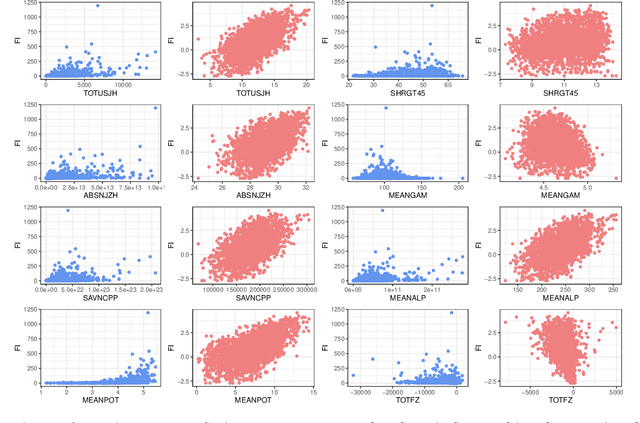
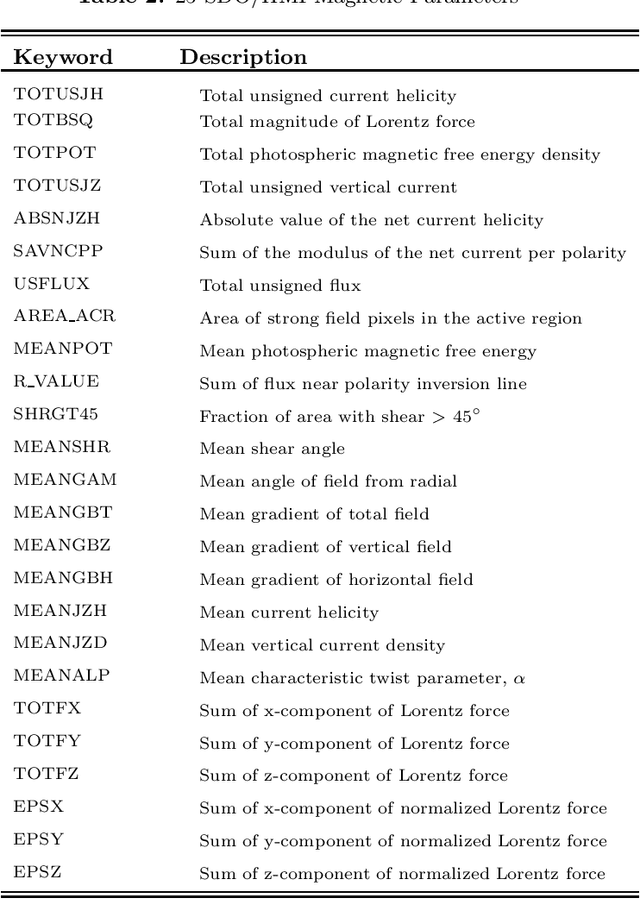
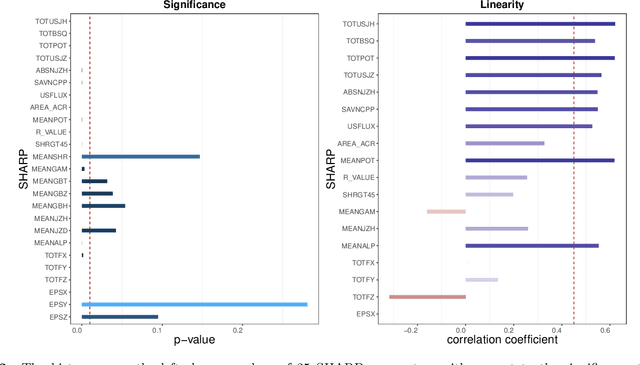
Abstract:Solar flares, especially the M- and X-class flares, are often associated with coronal mass ejections (CMEs). They are the most important sources of space weather effects, that can severely impact the near-Earth environment. Thus it is essential to forecast flares (especially the M-and X-class ones) to mitigate their destructive and hazardous consequences. Here, we introduce several statistical and Machine Learning approaches to the prediction of the AR's Flare Index (FI) that quantifies the flare productivity of an AR by taking into account the numbers of different class flares within a certain time interval. Specifically, our sample includes 563 ARs appeared on solar disk from May 2010 to Dec 2017. The 25 magnetic parameters, provided by the Space-weather HMI Active Region Patches (SHARP) from Helioseismic and Magnetic Imager (HMI) on board the Solar Dynamics Observatory (SDO), characterize coronal magnetic energy stored in ARs by proxy and are used as the predictors. We investigate the relationship between these SHARP parameters and the FI of ARs with a machine-learning algorithm (spline regression) and the resampling method (Synthetic Minority Over-Sampling Technique for Regression with Gaussian Noise, short by SMOGN). Based on the established relationship, we are able to predict the value of FIs for a given AR within the next 1-day period. Compared with other 4 popular machine learning algorithms, our methods improve the accuracy of FI prediction, especially for large FI. In addition, we sort the importance of SHARP parameters by Borda Count method calculated from the ranks that are rendered by 9 different machine learning methods.
Tracing Halpha Fibrils through Bayesian Deep Learning
Jul 16, 2021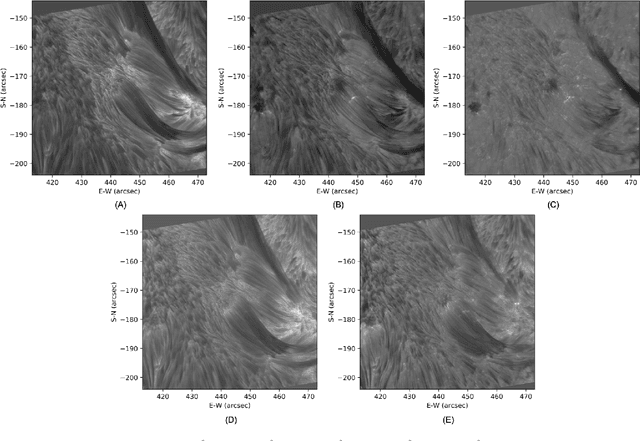

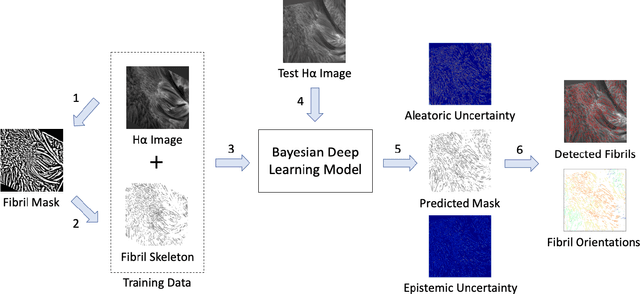

Abstract:We present a new deep learning method, dubbed FibrilNet, for tracing chromospheric fibrils in Halpha images of solar observations. Our method consists of a data pre-processing component that prepares training data from a threshold-based tool, a deep learning model implemented as a Bayesian convolutional neural network for probabilistic image segmentation with uncertainty quantification to predict fibrils, and a post-processing component containing a fibril-fitting algorithm to determine fibril orientations. The FibrilNet tool is applied to high-resolution Halpha images from an active region (AR 12665) collected by the 1.6 m Goode Solar Telescope (GST) equipped with high-order adaptive optics at the Big Bear Solar Observatory (BBSO). We quantitatively assess the FibrilNet tool, comparing its image segmentation algorithm and fibril-fitting algorithm with those employed by the threshold-based tool. Our experimental results and major findings are summarized as follows. First, the image segmentation results (i.e., detected fibrils) of the two tools are quite similar, demonstrating the good learning capability of FibrilNet. Second, FibrilNet finds more accurate and smoother fibril orientation angles than the threshold-based tool. Third, FibrilNet is faster than the threshold-based tool and the uncertainty maps produced by FibrilNet not only provide a quantitative way to measure the confidence on each detected fibril, but also help identify fibril structures that are not detected by the threshold-based tool but are inferred through machine learning. Finally, we apply FibrilNet to full-disk Halpha images from other solar observatories and additional high-resolution Halpha images collected by BBSO/GST, demonstrating the tool's usability in diverse datasets.
Identifying and Tracking Solar Magnetic Flux Elements with Deep Learning
Aug 27, 2020
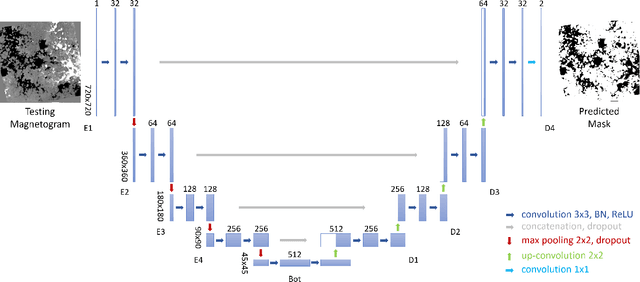

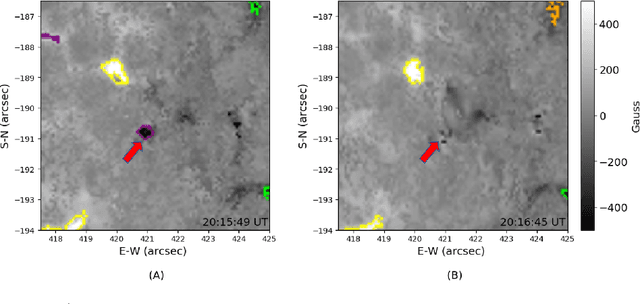
Abstract:Deep learning has drawn a lot of interest in recent years due to its effectiveness in processing big and complex observational data gathered from diverse instruments. Here we propose a new deep learning method, called SolarUnet, to identify and track solar magnetic flux elements or features in observed vector magnetograms based on the Southwest Automatic Magnetic Identification Suite (SWAMIS). Our method consists of a data pre-processing component that prepares training data from the SWAMIS tool, a deep learning model implemented as a U-shaped convolutional neural network for fast and accurate image segmentation, and a post-processing component that prepares tracking results. SolarUnet is applied to data from the 1.6 meter Goode Solar Telescope at the Big Bear Solar Observatory. When compared to the widely used SWAMIS tool, SolarUnet is faster while agreeing mostly with SWAMIS on feature size and flux distributions, and complementing SWAMIS in tracking long-lifetime features. Thus, the proposed physics-guided deep learning-based tool can be considered as an alternative method for solar magnetic tracking.
* 17 pages, 12 figures
 Add to Chrome
Add to Chrome Add to Firefox
Add to Firefox Add to Edge
Add to Edge